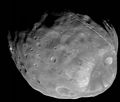ملف:Phobos colour 2008.jpg

حجم هذه المعاينة: 636 × 600 بكسل. الأبعاد الأخرى: 255 × 240 بكسل | 509 × 480 بكسل | 815 × 768 بكسل | 1٬086 × 1٬024 بكسل | 2٬172 × 2٬048 بكسل | 3٬500 × 3٬300 بكسل.
الملف الأصلي (3٬500 × 3٬300 بكسل حجم الملف: 2٫72 ميجابايت، نوع MIME: image/jpeg)
| هذه صورة مختارة، وهذا يعني أن مجتمع ويكيبديا العربية اتفق على تصنيفها واحدة من أفضل الصور في ويكيبيديا العربية، وتضيف شيئاً هامّاً إلى مقالها. إذا كنت تملك صورة أخرى ذات جودة مشابهة، فلا تتردد في رفعها مستخدماً ترخيصاً حرّاً مناسباً، وإضافتها إلى مقال مناسب، ومن ثم ترشيحها. |
تاريخ الملف
اضغط على زمن/تاريخ لرؤية الملف كما بدا في هذا الزمن.
| زمن/تاريخ | صورة مصغرة | الأبعاد | مستخدم | تعليق | |
|---|---|---|---|---|---|
| حالي | 03:10، 2 أبريل 2018 |  | 3٬500 × 3٬300 (2٫72 ميجابايت) | Kaldari | more margin on right side |
| 04:47، 13 نوفمبر 2008 |  | 3٬374 × 3٬300 (2٫7 ميجابايت) | Fir0002 | == Summary == {{Information |Description=Colour image of Phobos, imaged by the Mars Reconnaisance Orbiter in 2008 |Source=NASA |Date=9 April 2008 |Location=http://www.nasa.gov/mission_pages/MRO/multimedia/pia10368.html |Author=NASA/J |
استخدام الملف
ال18 صفحة التالية تستخدم هذا الملف:
- المريخ
- خط زمني لاكتشاف كواكب المجموعة الشمسية وأقمارها
- فوبوس
- قائمة أجرام المجموعة الشمسية مرتبة حسب الحجم
- قائمة الأقمار الطبيعية
- قمرا المريخ
- معسكر قاعدة المريخ
- ويكيبيديا:ترشيحات الصور المختارة/القمر فوبوس
- ويكيبيديا:صور مختارة/الفضاء والكون/نظرة إلى الأعلى
- ويكيبيديا:صورة اليوم المختارة/أغسطس 2019
- ويكيبيديا:صورة اليوم المختارة/يناير 2022
- قالب:صورة اليوم المختارة/2019-08-03
- قالب:صورة اليوم المختارة/2022-01-04
- بوابة:المريخ
- بوابة:المريخ/مقالة مختارة/2
- بوابة:المريخ/مقالة مختارة/أرشيف
- بوابة:علم الفلك/صورة مختارة
- بوابة:علم الفلك/صورة مختارة/73
الاستخدام العالمي للملف
الويكيات الأخرى التالية تستخدم هذا الملف:
- الاستخدام في af.wikipedia.org
- الاستخدام في an.wikipedia.org
- الاستخدام في ary.wikipedia.org
- الاستخدام في arz.wikipedia.org
- الاستخدام في as.wikipedia.org
- الاستخدام في azb.wikipedia.org
- الاستخدام في az.wikipedia.org
- الاستخدام في be-tarask.wikipedia.org
- الاستخدام في be.wikipedia.org
- الاستخدام في bg.wikipedia.org
- الاستخدام في bh.wikipedia.org
- الاستخدام في bn.wikipedia.org
- الاستخدام في bn.wikibooks.org
- الاستخدام في bs.wikipedia.org
- الاستخدام في ca.wikipedia.org
- الاستخدام في ckb.wikipedia.org
- الاستخدام في crh.wikipedia.org
- الاستخدام في cs.wikipedia.org
- الاستخدام في cv.wikipedia.org
- الاستخدام في de.wikipedia.org
- الاستخدام في de.wikivoyage.org
- الاستخدام في dsb.wikipedia.org
- الاستخدام في el.wikipedia.org
اعرض المزيد من الاستخدام العام لهذا الملف.




